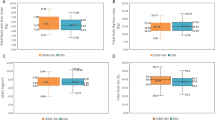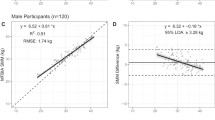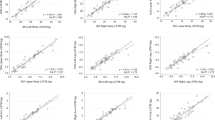Abstract
Background
Aging presents changes in muscle mass that may lead to sarcopenia. Identifying safe, quick, and accessible methods to assess muscle mass is imperative.
Aims
The purpose of this investigation was to compare the assessments of appendicular skeletal muscle mass (ASMM), fat-free mass (FFM), and fat mass (FM) between bioelectrical impedance analysis (BIA) and dual-energy X-ray absorptiometry (DXA).
Methods
Seventy-three healthy, community-dwelling, physically active males (n = 19) and females (n = 54) (BMI = 27.1 ± 4.3 kg m−2) between the ages of 55–85 years underwent total-body BIA and DXA. ASMM was estimated via BIA from a previously published regression equation while DXA ASMM was calculated as the sum of the measured total arm lean mass and total leg lean mass. Paired-samples t tests with a significance level of p < 0.05 were conducted, while agreement between the methods was assessed via Bland–Altman plots.
Results
In comparison to DXA, the chosen BIA equation overestimated ASMM (21.61 ± 5.82 kg vs. 18.82 ± 4.81 kg) and FFM (49.57 ± 9.94 kg vs. 46.22 ± 10.11 kg) and underestimated FM (24.59 ± 8.28 kg vs. 27.13 ± 10.01 kg), all p < 0.001. Visual inspection of the Bland–Altman plots revealed wide limits of agreement. Female participants were more clustered around the mean than male participants.
Discussion
The multifrequency BIA device and chosen ASMM estimation equation resulted in wide limits of agreement and significantly different comparisons to the reference method of DXA.
Conclusion
Future research should continue to investigate and validate methodologies to screen older individuals for characteristics of aging-related diseases, such as sarcopenia.

Similar content being viewed by others
Data availability
The datasets generated during and/or analysed during the current study are available from the corresponding author on reasonable request.
References
Cruz-Jentoft AJ, Baeyens JP, Bauer JM et al (2010) Sarcopenia: European consensus on definition and diagnosis: report of the European Working Group on Sarcopenia in older people. Age Ageing 39:412–423. https://doi.org/10.1093/ageing/afq034
Janssen I, Heymsfield SB, Baumgartner RN et al (2000) Estimation of skeletal muscle mass by bioelectrical impedance analysis. J Appl Physiol 89:465–471. https://doi.org/10.1152/jappl.2000.89.2.465
De Spiegeleer A, Petrovic M, Boeckxstaens P et al (2016) Treating sarcopenia in clinical practice: where are we now? Acta Clin Belg 71:197–205. https://doi.org/10.1080/17843286.2016.1168064
Anton SD, Hida A, Mankowski R et al (2018) Nutrition and exercise in sarcopenia. Curr Protein Pept Sci 19:649–667. https://doi.org/10.2174/1389203717666161227144349
Rubbieri G, Mossello E, Di Bari M (2014) Techniques for the diagnosis of sarcopenia. Clin Cases Miner Bone Metab 11:181–184
Sergi G, De Rui M, Veronese N et al (2015) Assessing appendicular skeletal muscle mass with bioelectrical impedance analysis in free-living Caucasian older adults. Clin Nutr 34:667–673. https://doi.org/10.1016/j.clnu.2014.07.010
Snyder W, Cook M, Nasset E et al (1975) Report of the task group on reference men. In: 23rd International commission on radiological protection, Oxford, UK
Gallagher D, Visser M, De Meersman RE et al (1997) Appendicular skeletal muscle mass: effects of age, gender, and ethnicity. Am Physiol Soc 83:229–239. https://doi.org/10.1152/jappl.1997.83.1.229
Andreoli A, Scalzo G, Masala S et al (2009) Body composition assessment by dual-energy X-ray absorptiometry (DXA). Radiol Med 114:286–300. https://doi.org/10.1007/s11547-009-0369-7
Kyle UG, Genton L, Hans D et al (2003) Validation of a bioelectrical impedance analysis equation to predict appendicular skeletal muscle mass (ASMM). Clin Nutr 22:537–543. https://doi.org/10.1016/s0261-5614(03)00048-7
Kim M, Shinkai S, Murayama H et al (2015) Comparison of segmental multifrequency bioelectrical impedance analysis with dual-energy X-ray absorptiometry for the assessment of body composition in a community-dwelling older population. Geriatr Gerontol Int 15:1013–1022. https://doi.org/10.1111/ggi.12384
Sjöström L (1991) A computer-tomography based multicompartment body composition technique and anthropometric predictions of lean body mass, total and subcutaneous adipose tissue. Int J Obes 15 Suppl 2:19–30
Beaudart C, Bruyère O, Geerinck A et al (2020) Equation models developed with bioelectric impedance analysis tools to assess muscle mass: a systematic review. Clin Nutr ESPEN 35:47–62. https://doi.org/10.1016/j.clnesp.2019.09.012
Pietrobelli A, Morini P, Battistini N et al (1998) Appendicular skeletal muscle mass: prediction from multiple frequency segmental bioimpedance analysis. Eur J Clin Nutr 52:507–511. https://doi.org/10.1038/sj.ejcn.1600592
Lee SY, Ahn S, Kim YJ et al (2018) Comparison between dual-energy X-ray absorptiometry and bioelectrical impedance analyses for accuracy in measuring whole body muscle mass and appendicular skeletal muscle mass. Nutrients 10:738–752. https://doi.org/10.3390/nu10060738
Janssen I, Heymsfield SB, Ross R (2002) Low relative skeletal muscle mass (sarcopenia) in older persons is associated with functional impairment and physical disability. J Am Geriatr Soc 50:889–896. https://doi.org/10.1046/j.1532-5415.2002.50216.x
Cohen J (2013) Statistical power analysis for the behavioral sciences. Routledge, London
Bland JM, Altman DG (1986) Statistical methods for assessing agreement between two methods of clinical measurement. Lancet 1:307–310
Weir JP (2005) Quantifying test-retest reliability using the intraclass correlation coefficient and the SEM. J Strength Cond Res 19:231–240. https://doi.org/10.1519/15184.1
ACSM (2013) ACSM’s guidelines for exercise testing and prescription. Lippincott Williams & Wilkins, Philadelphia
González Correa CH, Marulanda Mejía F, Castaño González PA et al (2020) Bioelectrical impedance analysis and dual X-ray absorptiometry agreement for skeletal muscle mass index evaluation in sarcopenia diagnosis. Physiol Meas 41:064005. https://doi.org/10.1088/1361-6579/ab8e5f
Cruz-Jentoft AJ, Bahat G, Bauer J et al (2019) Sarcopenia: revised European consensus on definition and diagnosis. Age Ageing 48:16–31. https://doi.org/10.1093/ageing/afy169
Tengvall M, Ellegård L, Malmros V et al (2009) Body composition in the elderly: reference values and bioelectrical impedance spectroscopy to predict total body skeletal muscle mass. Clin Nutr 28:52–58. https://doi.org/10.1016/j.clnu.2008.10.005
Fielding RA, Vellas B, Evans WJ et al (2011) Sarcopenia: an undiagnosed condition in older adults. Current consensus definition: prevalence, etiology, and consequences. International working group on sarcopenia. J Am Med Dir Assoc 12:249–256. https://doi.org/10.1016/j.jamda.2011.01.003
Baumgartner RN, Koehler KM, Gallagher D et al (1998) Epidemiology of sarcopenia among the elderly in New Mexico. Am J Epidemiol 147:755–763. https://doi.org/10.1093/oxfordjournals.aje.a009520
Noppa H, Andersson M, Bengtsson C et al (1979) Body composition in middle-aged women with special reference to the correlation between body fat mass and anthropometric data. Am J Clin Nutr 32:1388–1395. https://doi.org/10.1093/ajcn/32.7.1388
Achamrah N, Colange G, Delay J et al (2018) Comparison of body composition assessment by DXA and BIA according to the body mass index: a retrospective study on 3655 measures. PLoS One 13:e0200465. https://doi.org/10.1371/journal.pone.0200465
Bosaeus I, Wilcox G, Rothenberg E et al (2014) Skeletal muscle mass in hospitalized elderly patients: comparison of measurements by single-frequency BIA and DXA. Clin Nutr 33:426–431. https://doi.org/10.1016/j.clnu.2013.06.007
Funding
Data collection was made possible by the University new faculty general research fund (NFGRF-2019) University of Kansas, Lawrence, KS, USA.
Author information
Authors and Affiliations
Contributions
AAH acquired funding for study supplies and obtained IRB approval. AAH collected the data and design the study design. CJC wrote the first draft of the manuscript with AAH’s oversight and approval. CJC and AAH reviewed and approved the final version of the manuscript.
Corresponding author
Ethics declarations
Conflict of interest
On behalf of all authors, the corresponding author states that there is no conflict of interest.
Ethical approval
All procedures performed in studies involving human participants were in accordance with the ethical standards of the institutional research committee and with the 1964 Helsinki Declaration and its later amendments or comparable ethical standards. The study was approved by the Human Research Protection Program at the University of Kansas (No. STUDY00143495).
Informed consent
Informed consent was obtained from all individual participants included in the study.
Additional information
Publisher's Note
Springer Nature remains neutral with regard to jurisdictional claims in published maps and institutional affiliations.
Rights and permissions
About this article
Cite this article
Herda, A.A., Cleary, C.J. Agreement between multifrequency BIA and DXA for assessing segmental appendicular skeletal muscle mass in older adults. Aging Clin Exp Res 34, 2789–2795 (2022). https://doi.org/10.1007/s40520-021-02000-z
Received:
Accepted:
Published:
Issue Date:
DOI: https://doi.org/10.1007/s40520-021-02000-z




